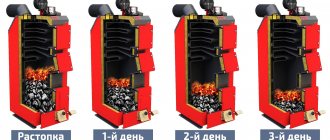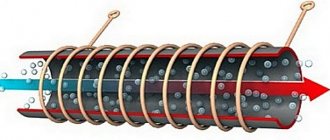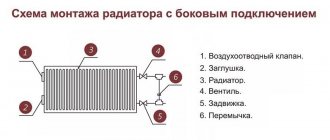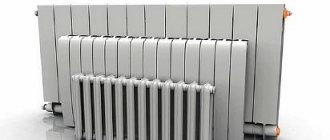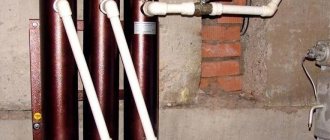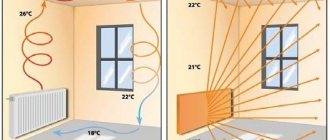Owners of country houses and cottages with large balconies or panoramic windows in winter may encounter the problem of window fogging (due to the difference in temperature, a “dew point” is created on the internal and external glazing, which leads to the formation of condensation on the glass indoors). The windows constantly “cry”, as a result of which mold forms in the rooms. To prevent this, the most ideal option in this case would be to install an in-floor heating convector.
Convector heaters built into the floor under stained glass windows form a thermal curtain that prevents the glass from fogging and cuts off the cold background from the window opening.
In addition, convectors also perform a decorative function. They can be either almost invisible or combined with the design of the premises. The variety of colors and materials for manufacturing decorative grilles for these products allows designers to add convectors to any modern interior.
Types of in-floor convectors
Based on the source of thermal energy, the following types of convection heaters are distinguished:
- Mermen.
A type of convector with a built-in heat exchanger through which coolant heated from a boiler or heating networks circulates. Convector fins provide rapid heating of the air. These devices come with natural and forced convection. The design of the former allows air to circulate naturally, the latter are equipped with built-in fans that help air circulate, thereby increasing the power of the device (requires an electrical connection). Based on the type of installation, built-in, floor and wall structures are distinguished. - Electrical. A common type of heating device for short-term use. Despite the affordable cost and ease of installation, it is not economically profitable to heat a residential building with such a unit around the clock
Which options are easier to get by with?
If the ceiling height exceeds the standard, which is about 3 meters, then warm air will accumulate under the ceiling - the room will remain unheated.
For a budget overhaul of an apartment or house, it is more advisable to choose an ordinary radiator battery. This is due to the fact that the cost of this element of the heating system averages 5 thousand rubles. The price of floor-mounted water heating convectors built into the floor with similar power parameters as radiator ones is approximately 10 times higher. Designer models of classic radiator versions that fit harmoniously into a modern interior can be comparable in price.
Advantages and disadvantages of water heating convector
The use of convection heating devices has a number of advantages:
- Lightness of design
. Convectors do not create a large load on the structural elements of the building. - No condensation on windows
. The convection heating method eliminates condensation on the windows and protects the house from the possible formation of fungus and mold. - High thermal output and low inertness
. As a rule, convector heat exchangers are made of copper or aluminum pipes, which heat up quickly and have high heat transfer. - Easy to maintain
. In-floor structures do not take up useful space; they can be installed in the floor and even stairs or window sills. In the event of a breakdown, it is enough to remove the grille and replace the failed element. - Versatility
. Convector appliances are installed in rooms of any type: hallways, kitchens, bedrooms, children's rooms, swimming pools or garden houses, etc. These units have gained great popularity in office and shopping and entertainment buildings with a large number of panoramic windows. - Compact size and attractive appearance
. In-floor convectors are not visible to the naked eye; this design will fit perfectly into any interior. - Long service life
. The official warranty from manufacturers is provided for up to 15 years, and with proper use and constant maintenance, the equipment will last for many years.
The disadvantages include the following:
- Low thermal power (compared to radiators).
- Creation of noise from fans (in devices with forced air circulation).
- Convection heating creates conditions for the movement of dust in the air. It is recommended to carry out wet cleaning more often.
- Difficult to install. Installation of built-in convectors is more complex and expensive compared to installation of radiators. Particularly difficulties can arise if these devices were not included in the project initially and the rooms are screeded.
Selection options
When choosing a heating convector for your home, you should consider a number of important factors.
Power and heat dissipation of the device
. To effectively heat a home, it is necessary to correctly calculate the heat demand of the room, taking into account possible heat loss and the design features of the residential building. Depending on the power, the optimal size of the equipment is selected.
Also pay attention to the area of the heat exchanger: this indicator affects the rate of heating of the air masses (the larger the area, the faster the room will warm up).
Convection type
. Convectors with natural and forced convection are available for sale. The built-in fan speeds up the heat exchange process and ensures quick heating of the room, however, this type of device raises more dust and can create noise. It is most rational to install such devices under panoramic windows or in elongated rooms where natural air ventilation is impaired.
If we compare convectors of the same power with forced and natural air circulation, the former will be much smaller in size than the latter. This is another factor in favor of convectors with forced air circulation, since sometimes it is not possible to install a large convector in all rooms.
The built-in fan operates from the mains, so it is worth considering the quality of the electrical wiring at home and the possibility of connecting the device. It is also worth remembering the additional energy consumption.
Heat exchanger material and connection quality
. Choose heating devices with solid heat exchangers and pay attention to the quality of the connections. Typically, heat exchange tubes are made of copper or aluminum alloy. Such materials are resistant to corrosion and conduct heat well.
Decorative lattice
. The number of lamellas and the distance between them can also affect the quality of heat exchange. A large distance between the elements reduces the rigidity of the structure; a lattice that is too thick reduces the heating efficiency.
In addition, the grille plays an important role in interior design. A rich color variety of decorative elements made of aluminum and wood allows the heating device to fit into any interior.
Installation method
. When choosing in-floor convectors as heating devices, it is worth thinking about it at the design stage. If these devices are not included in the project in advance, difficulties may arise with their installation, which will entail more time and money.
Moisture protection
. When choosing models with forced ventilation or devices for placement in rooms with high humidity, pay attention to the degree of protection of the device and the quality of the material from which its body is made. Designs with protection class IP65 will prevent dust and moisture from entering important elements of the convector. If indoor humidity is very high (for example, swimming pools), it is worth choosing galvanized models that protect devices from rust and corrosion.
Operating pressure and maximum coolant temperature are not the primary indicators when choosing a convector heater for a private home, because An autonomous heating system is used here. However, in houses with an installed solid fuel boiler, it is recommended to install convectors whose heat exchanger can withstand liquid temperatures up to 110 °C and higher.
How to choose the right floor-mounted convector for a specific room?
Now let’s look at the main indicators and characteristics that should be taken into account when calculating heat transfer and the specific power of the future convector.
The power parameters of the model are calculated from the dimensions of the room (area). The most adequate and efficient calculation for heating is 110 W of power per square meter of area. This figure is taken with some reserve - for Ukrainian heating conditions. In Europe the figure is an order of magnitude lower.
So, let's move on to a specific calculation example. Let's say we have a room with an area of 50 square meters. m. We take our fifty squares and multiply them by the figure proposed above. It turns out that we will need a device with a power of 5500 W.
In addition, there are a number of nuances (coefficients) that should be taken into account:
- ceiling height over 2.8 meters (additionally multiply by 1.05);
- additional coefficient 1.2 if the room has at least two external walls;
- if the walls are without insulation, multiply by 1.1.
There are a number of additional parameters that are taken into account when calculating the power of the convector. When making detailed calculations, the following are taken into account:
- window sizes;
- coolant quality;
- screed depth;
- heating system throughput, etc.
The presence of additional heating systems is also important. Of course, the power of other devices involved in heating cannot be neglected.
To more accurately calculate the required heat transfer, you can use a special online calculator.
Rating of water convectors. TOP 5
The market offers a wide range of convector heaters of different configurations and manufacturers. To simplify the task and help you select the required unit, we bring to your attention a list of popular models that are most in demand among our customers:
- Novaterm NT-V 09-25-120
The water convector has an attractive price and high heat output. Suitable for installation in both single-pipe and two-pipe heating systems.
- KZTO Breeze 200-80-1800
Trench convector in a stainless steel housing. The copper heat exchanger allows you to quickly warm up the air in the room.
- Varmann Qtherm 230-75-1000
High-quality water convector heater, which can be used both as a main and additional heat source.
- Techno Power KVZ 300-85-1700
The natural convection heater is equipped with a copper heat exchanger and aluminum convector fins, and is characterized by high heat transfer and performance. Unfortunately, it can only boast a good price, but not quality workmanship and good materials.
- Kermi KVN 230-80-1500
The heating device of a popular brand is reliable and durable. Official manufacturer's warranty: 10 years.
Standard solutions for some premises
First of all, you need to decide on the area of the room that will need to be heated. For large areas of office space or shopping centers, it is necessary to install several heating devices at once, and it is advisable to provide them with forced ventilation. For extremely large areas there should be several priors. Also, based on the level of required heat transfer, you should decide which heating option is better - water or electric? The first one will be cheaper to operate, but there may be problems with quickly warming up the room. The second one will cost a pretty penny, but will ensure uniform and timely heating.
Apartment convectors and models for small offices will be less demanding in terms of installation conditions. Due to the small heating area, it is possible not to use additional fans in them, but also to use central water heating.
Conclusion
Underfloor convectors are an excellent alternative to water radiator heating. Design features allow the devices to fit into any interior. In private homes with non-standard window openings and layouts, convectors will be an ideal addition.
— specialized online store of heating equipment. By contacting us, you will receive not only a high-quality product with an official guarantee from the manufacturer, but also qualified assistance from specialists with many years of experience.
